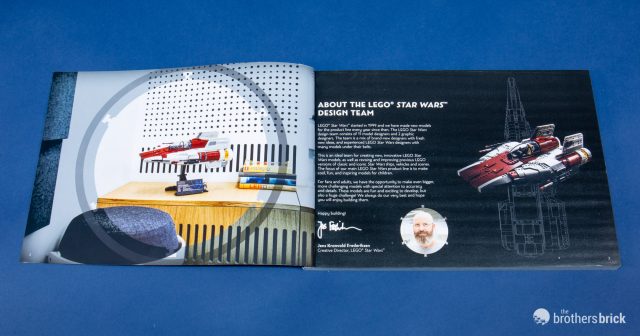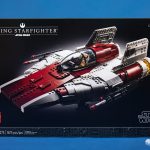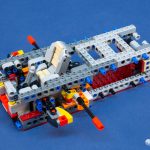Last month LEGO revealed the next set in the Ultimate Collector Series would be 75275 A-wing Starfighter, making it available May 1 just in time for May the Fourth celebrations. Due to the current global pandemic, LEGO’s shipping department wasn’t able to get us an early copy, but we’ve finally got our hands on the set to bring you an in-depth review. The new Rebel fighter has 1,673 pieces and is available now for US $199.99 | CAN $259.99 | UK £179.99.
The box and contents
LEGO has significantly redesigned its packaging for certain LEGO Star Wars sets released so far in 2020, including this UCS set as well as the recently released LEGO Star Wars helmets. Both designs feature the set name in large, all-caps, serif writing. The LEGO and Star Wars logos are both much smaller than on previous sets, while the vehicle itself is featured on a plain black background without “action” features like laser blasts and engine exhaust. Finally, the product details are also much less prominent, leading with an “18+” age recommendation for the first time in UCS history.
See the gallery at the end of this article for a view of the back of the box as well as a comparison with the UCS Y-wing released exactly two years ago.
The box includes eleven numbered bags, with the 8×16 tile for the specifications and the cockpit canopy loose in the box (the latter fortunately in a protective bag), plus the instruction booklet and sticker sheet in its own wrapper.
There’s no monstrous, spiral-bound instruction book in this set — although certainly larger than a regular set, the instructions are printed using the same perfect-bound approach used for most LEGO Ideas and LEGO Architecture sets. Meanwhile, there are two separate sticker sheets — one for details on the A-wing’s body, together with the specification sticker, and a second sticker sheet printed on clear backing for the (shudder…) details on the trans-clear canopy.
The build
As we’ll see over the course of this review, the Rebel A-wing’s complex curves require equally complex LEGO solutions achieved in the new UCS A-wing. The first bag produces nothing but a Technic frame with an internal mechanism for flipping the laser cannons back and forth.
Similarly, the second bag merely adds more Technic for the vehicle’s core, although the interior of the cockpit does begin to take shape, with the seat and control stick. More Technic beams extend forward from the square core to support the lower and upper skin of the fighter’s flattened nose.
The next two bags include the parts for the curved sections on either side of the red nose section. This is another complex set of top/bottom subassemblies, though the gap near the front of each serves more of a purpose, as we’ll see on the finished model.
These sections attach via ball joints and are pinned in place with 3L bar pieces, leaving me to wonder how disassembly will work should I choose to part this out into my collection later. The cockpit comes together with the parts from Bag 9. Applying stickers to clear canopies can be particularly challenging — thus the shuddering dread I immediately felt upon opening the box, when I saw the unprinted canopy accompanied by a sticker sheet. However, the three separate stickers that make up the black frame details on the trans-clear canopy piece went on without much of a hitch.
The completed model
The Kuat Systems Engineering RZ-1 A-wing interceptor first appeared in Return of the Jedi (1983) during the Battle of Endor to destroy the second Death Star, although the Rebels animated series introduced A-wing prototypes earlier in the timeline during its TV run more recently. When complete, this LEGO A-wing has a significant heft to it, making it impossible to mistake it merely for an over-sized minifig-scale version, like 75248 Resistance A-wing released ahead of The Rise of Skywalker last year, or the many earlier Rebel A-wings going all the way back to 2000.
The complexity of the interior structure pays off with the compound curves built from slopes attached sideways and upside down. As a result, the fighter looks great from just about any angle.
The canopy fits snugly over the cockpit, with a fuselage section behind it that continues the sleek shape. Although assembled and attached to the body together, the actual canopy detaches from the fuselage easily enough to take a closer look inside.
As anybody who has played a starfighter-oriented Star Wars video game like Star Wars: Rogue Squadron II – Rogue Leader (released for the Nintendo GameCube in 2001) is fully aware, A-wing laser cannons can be reversed to fire backward. I don’t recall this feature ever appearing in official “canon” material, but it’s great to see this play feature reproduced faithfully in the UCS A-wing. The interior mechanism works very smoothly, although the laser cannons sit most naturally facing forward or back. Each side of the nose also features concussion missile launcher tubes, thankfully not provided with flick-fire or spring-loaded missiles.
As our readers and many other LEGO fans were quick to point out when the set was officially announced several weeks ago, the specification plaque has several errors, including “Kuat System Engineering” rather than Kuat Systems Engineering, incorrect vehicle length (reflecting older, non-canonical reference materials rather than more recent Lucasfilm info), missing pluralization of the concussion missile launchers, and more. This isn’t a point worth belaboring further here, except in the context of the increasing number of copyediting errors, instruction step errors, and other quality issues we’ve observed in the past 2-3 years in LEGO’s printed materials.
The stand provides some flexibility in how you can choose to display your finished A-wing, either upright or at an angle. And since the connection between the A-wing and the stand is square, you could also place it on the stand facing front rather than sideways.
The minifigure
The only minifigure included in the set is a generic Rebel A-wing pilot. Although fairly similar to the A-wing pilot included in the 2013 A-wing Starfighter (75003) set, we learned in the interview with the set designer that the team updated the design and added details.
The reversible head seems to indicate that the pilot is actually Arvel Crynyd, the pilot who flew his A-wing into the bridge of Darth Vader’s flagship Super Star Destroyer Executor. Despite this name now being part of the (new) official canon, LEGO does not name the pilot as Green squadron leader Commander Crynyd.
Conclusion and recommendation
There is certainly much to criticize about the UCS A-wing, from the lack of landing gear and the single minifig to the specification plaque errors. The price at $200 for about 1,700 pieces is especially troubling, given the lack of printed parts and minifigs. I’m not a LEGO builder who insists that LEGO prices can never go up and that they must always stay below some arbitrary price-per-part ratio, but this feels like a bit of a higher jump than one might expect.
And yet, it’s hard not to love the finished model as a display piece, and the incredibly complex build was very enjoyable indeed. It’s also important to remember that this is the very first UCS-scale A-wing, filling a major gap in the UCS line of LEGO Star Wars sets. As I consider the set in its totality, all of the points I made above criticizing it feel like nit-picks, as valid and (hopefully) objective as I intend them to be. In other words, the UCS A-wing is much more than the sum of its imperfect parts.
75275 A-wing Starfighter has 1,673 pieces and 1 minifigure. It is available now from LEGO for US $199.99 | CAN $259.99 | UK £179.99, and may also be available from third-party retailers on Amazon and eBay.
Be sure to check out our interview with the set’s creator, LEGO Star Wars designer Hans Schlömer.





























































































I was a bit bothered by the fact that the stabilizers didn’t have click joints to ensure that the angle on all 4 is consistent. I can confirm that I also had trouble getting the engines to attach correctly (at one point the red cowling with the sticker on it fell off and I had to try 3-4 times to reattach it since the flimsy yellow slope on the inside kept felling off.
As far as the inserted 3L bar goes, I ran into trouble with that, too. I accidentally left out two pieces on the interior leading to a larger gap on the side than there should be. There was indeed no way to remove it (the included brick separator is woefully inadequate to the task) so I ended up having to strip off the top and bottom arches in situ.
I agree with the critique of the bottom feeling unfinished – after seeing them do this much more successfully with the B-wing it feels like an odd oversight. At least when on the stand it isn’t apparent without looking at it from underneath.
100% agree with the review. I also had trouble attaching the engines – I’m pretty sure they’re in the right place because there’s a section that visually aligns with a white tile above it, so I don’t think I’m supposed to push it in any further. The underside was also disappointing, especially when looking at the McQuarrie painting and you can see the underside of an A-wing – the reference material is clearly there. And I agree with Andy’s comment on the stabilizers – if they’re off, the entire stabilizer looks like it’s disjointed. Either a click joint or other mechanism to get the right angle would’ve been preferred.
One other small nit: I think some of the Technic connections should’ve been bolstered with plates. At one point I was pressing on a section that had two Technic bricks only connected with pins and the connection started to bend. I had to hold the model in a different way to get a finger underneath the bricks.
That being said, I think the nose and forward sections look fantastic. More than anything, I was excited to finally build a ‘new’ UCS model (skipped the SD, Falcon, DS, etc.)
Thanks for the review, guys. Always enjoy reading them.
“Both designs feature the set name in large, all-caps, sans-serif writing”
Yikes! That font definitely has serifs!
D’oh, great catch on that serif note. We definitely know the difference, but wires get crossed sometimes. We’ve corrected it now.
I finished building mine today and my only real gripe was that the cockpit sticker that goes over the top could have been made longer than needed and then trimmed to make a better fit. If you’re going to put stickers on something that complicated in curves, just admit it’s going to be tricky and design in some leeway — I really doubt that 0.004¢ of extra sticker length would have shot the model’s production costs to hell.
The underside is not all that unfinished, there isn’t really much under an A-Wing.
The clicky fins would not have fallen into the right position, so I give that a pass.
Overall, I am pretty happy with the set. It is well-proportioned, an interesting build, and looks great. Since it will probably also be my last lego set, it is especially nice for it to have been a really good one.
Oh, and as for the 3L rod, just don’t push it all the way in. The parts over it will accept a nub sticking out and then you can pull it back out with tweezers or needle-nose soft jaws.